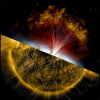2022
Compact groups from semi-analytical models of galaxy formation-III. Purity and completeness of Hickson-like catalogues Journal Article
In: Monthly Notices of the Royal Astronomical Society, 511 (4), pp. 4741-4752, 2022, (cited By 5).
Numerical simulations of bar formation in the Local Group Journal Article
In: Monthly Notices of the Royal Astronomical Society, 511 (2), pp. 2423-2433, 2022, (cited By 3).
Imprints of the cosmic void evolution on the baryon processes inside galaxy haloes Journal Article
In: Monthly Notices of the Royal Astronomical Society, 511 (2), pp. 2688-2701, 2022, (cited By 3).
The evolution of the oxygen abundance gradients in star-forming galaxies in the eagle simulations Journal Article
In: Monthly Notices of the Royal Astronomical Society, 511 (2), pp. 1667-1684, 2022, (cited By 11).
Atmospheric mass-loss and stellar wind effects in young and old systems - I. Comparative 3D study of TOI-942 and TOI-421 systems Journal Article
In: Monthly Notices of the Royal Astronomical Society, 510 (2), pp. 2111-2126, 2022, (cited By 7).
In: Monthly Notices of the Royal Astronomical Society, 510 (2), pp. 1934-1944, 2022, (cited By 6).
An inventory of galaxies in cosmic filaments feeding galaxy clusters: Galaxy groups, backsplash galaxies, and pristine galaxies Journal Article
In: Monthly Notices of the Royal Astronomical Society, 510 (1), pp. 581-592, 2022, (cited By 21).
The impact of coronal mass ejections and flares on the atmosphere of the hot Jupiter HD189733b Journal Article
In: Monthly Notices of the Royal Astronomical Society, 509 (4), pp. 5858-5871, 2022, (cited By 24).
Ill-posedness of the mean-field dynamo equations with a linear electromotive force Journal Article
In: Physica D: Nonlinear Phenomena, 430 , 2022, (cited By 0).
An Infrared View of the Obscured AGN Environment in NGC 4945 Journal Article
In: Astronomical Journal, 163 (5), 2022, (cited By 0).
The impact of void environment on AGN Journal Article
In: Monthly Notices of the Royal Astronomical Society, 509 (2), pp. 1805-1819, 2022, (cited By 7).
Redshift-space effects in voids and their impact on cosmological tests - II. The void-galaxy cross-correlation function Journal Article
In: Monthly Notices of the Royal Astronomical Society, 509 (2), pp. 1871-1884, 2022, (cited By 11).
Unveiling the internal structure of the Hercules supercluster Journal Article
In: Monthly Notices of the Royal Astronomical Society, 509 (3), pp. 3470-3487, 2022, (cited By 4).
Easy asteroid phase curve fitting for the Python ecosystem: Pyedra Journal Article
In: Astronomy and Computing, 38 , 2022, (cited By 1).
The probability of galaxy- galaxy strong lensing events in hydrodynamical simulations of galaxy clusters Journal Article
In: Astronomy and Astrophysics, 668 , 2022, (cited By 9).
Accurate dark-matter halo elongation from weak-lensing stacking analysis Journal Article
In: Monthly Notices of the Royal Astronomical Society, 517 (4), pp. 4827-4844, 2022, (cited By 1).
Star formation quenching in the infall region around galaxy clusters Journal Article
In: Monthly Notices of the Royal Astronomical Society, 517 (3), pp. 4515-4528, 2022, (cited By 3).
Conditions for Convergent Migration of N-Planet Systems Journal Article
In: Celestial Mechanics and Dynamical Astronomy, 134 (6), 2022, (cited By 1).
Observational and numerical characterization of a recurrent arc-shaped front propagating along a coronal fan Journal Article
In: Astronomy and Astrophysics, 667 , 2022, (cited By 0).
Revealing the properties of void galaxies and their assembly using the eagle simulation Journal Article
In: Monthly Notices of the Royal Astronomical Society, 517 (1), pp. 712-731, 2022, (cited By 8).








